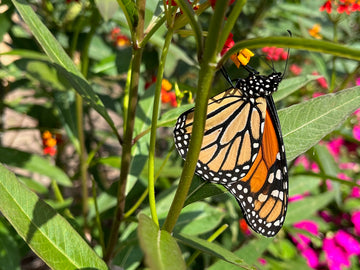What does a Monarch Butterfly look like and how is it different to the Viceroy butterfly?

Monarch Butterflies (Danaus plexippus) and Viceroy Butterflies (Limenitis archippus) are two distinct butterfly species, but they share some similarities in appearance. Here's a description of each butterfly and how they can be differentiated:
Monarch Butterfly:
-
Coloration: Monarch Butterflies have bright orange wings with black veins and borders. They also have white spots along the edges of their wings.
-
Size: Monarchs are relatively large butterflies with a wingspan ranging from 3.5 to 4 inches (8.9 to 10.2 cm).
-
Wing Shape: Monarch wings are elongated and somewhat triangular, with a distinctive appearance when in flight.
-
Antennae: They have long, slender antennae.
-
Habitat: Monarchs are commonly found in a wide range of habitats, including fields, meadows, gardens, and along migration routes.
-
Host Plant: Monarch caterpillars feed exclusively on milkweed plants, which makes them unpalatable to predators and contributes to their toxicity.
Viceroy Butterfly:
-
Coloration: Viceroy Butterflies also have orange wings with black veins, similar to Monarchs. However, they lack the white spots found on Monarch wings. Instead, Viceroys have a horizontal black band across the lower part of their hindwings.
-
Size: Viceroys are slightly smaller than Monarchs, with a wingspan of about 2.75 to 3.25 inches (7 to 8.3 cm).
-
Wing Shape: Viceroy wings are more rounded and less elongated than Monarch wings.
-
Antennae: Like Monarchs, Viceroys have long, slender antennae.
-
Habitat: Viceroys are commonly found in wetlands, near water bodies, and in other similar habitats.
-
Mimicry: One of the most significant differences between Monarch and Viceroy butterflies is that Viceroys mimic the appearance of Monarchs to gain protection from predators. The horizontal black band on their hindwings resembles the black veins on Monarch wings. This mimicry helps protect Viceroys from predators, as Monarchs are unpalatable due to their milkweed diet.
In summary, while Monarch and Viceroy butterflies share some visual similarities, such as the orange coloration and black veins, the presence of white spots, the horizontal black band on the hindwings, size differences, and habitat preferences can help distinguish the two species. The mimicry displayed by Viceroys is a fascinating example of evolutionary adaptation to avoid predation.





